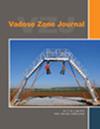利用时空分析描述蒸散发表面屏障内的土壤水分动态
IF 2.8
3区 地球科学
Q3 ENVIRONMENTAL SCIENCES
引用次数: 0
摘要
蒸散发(ET)表面屏障在补给期间储存入渗降水,并通过蒸散发将储存的水释放到大气中。表面屏障的主要目的是减少或消除向下层废物区的排水。本研究的目的是基于观测和模拟数据,分析蒸散发表面屏障内土壤水分的时空动态。本研究利用深度时域土壤含水量和通量率等高线图来表征水的运动过程。零通量面(ZFPs)将深度时域划分为储水区、ET区和排水区。结合模拟结果阐述了现场未观测到的一些流动动力学(流速、流向等),确定了入渗水补给前沿深度、储水释放前沿深度和ET区底部深度。蒸散发-排水分界标志着蒸散发带的底部和排水带的顶部。结果表明,土壤水分储存的时间分析可以反映地表屏障储水量的利用程度。土壤水分含量和通量的时空分析可以表征补给/释放过程的持续时间和储水的深度。这些过程和相关区域的量化有助于了解一系列天气和植被条件下土壤水分的状态和动态,并有助于优化蒸散发表面屏障的设计。本文章由计算机程序翻译,如有差异,请以英文原文为准。
Delineating soil moisture dynamics within an evapotranspiration surface barrier using spatial‐temporal analysis
Evapotranspiration (ET) surface barriers store infiltrated precipitation during the recharge period and release the stored water to the atmosphere via ET. The primary purpose of a surface barrier is to reduce or eliminate drainage to the underlying waste zone. The objective of this study is to analyze the spatial and temporal dynamics of soil moisture within an ET surface barrier based on observed and simulated data. This study characterizes the water movement processes using contour plots of soil moisture content and flux rate in the depth‐time domain. Zero‐flux planes (ZFPs) divide the depth‐time domain into stored water, ET, and drainage zones. Some flow dynamics (e.g., flow rate and direction) that were not observed in the field were elaborated with simulation results to identify the depth of the recharge front of infiltrated water, the release front of stored water, and the bottom of the ET zone. The ET‐drainage divide marks the bottom of the ET zone and the top of the drainage zone. The results showed that the temporal analysis of soil moisture storage could indicate the degree of usage of the storage capacity of a surface barrier. The spatial‐temporal analyses of soil moisture content and flux rate can characterize the durations of the recharge/release processes and the depth of the stored water. Quantification of these processes and related zones provides beneficial understanding of the state and dynamics of soil moisture for a range of weather and vegetation conditions and is useful in optimizing the design of an ET surface barrier.
求助全文
通过发布文献求助,成功后即可免费获取论文全文。
去求助
来源期刊

Vadose Zone Journal
环境科学-环境科学
CiteScore
5.60
自引率
7.10%
发文量
61
审稿时长
3.8 months
期刊介绍:
Vadose Zone Journal is a unique publication outlet for interdisciplinary research and assessment of the vadose zone, the portion of the Critical Zone that comprises the Earth’s critical living surface down to groundwater. It is a peer-reviewed, international journal publishing reviews, original research, and special sections across a wide range of disciplines. Vadose Zone Journal reports fundamental and applied research from disciplinary and multidisciplinary investigations, including assessment and policy analyses, of the mostly unsaturated zone between the soil surface and the groundwater table. The goal is to disseminate information to facilitate science-based decision-making and sustainable management of the vadose zone. Examples of topic areas suitable for VZJ are variably saturated fluid flow, heat and solute transport in granular and fractured media, flow processes in the capillary fringe at or near the water table, water table management, regional and global climate change impacts on the vadose zone, carbon sequestration, design and performance of waste disposal facilities, long-term stewardship of contaminated sites in the vadose zone, biogeochemical transformation processes, microbial processes in shallow and deep formations, bioremediation, and the fate and transport of radionuclides, inorganic and organic chemicals, colloids, viruses, and microorganisms. Articles in VZJ also address yet-to-be-resolved issues, such as how to quantify heterogeneity of subsurface processes and properties, and how to couple physical, chemical, and biological processes across a range of spatial scales from the molecular to the global.
 求助内容:
求助内容: 应助结果提醒方式:
应助结果提醒方式:


